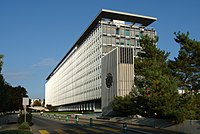
Photo from wikipedia
This article is part of the Research Topic ‘Health Systems Recovery in the Context of COVID-19 and Protracted Conflict’. As the world faces global health crises such as pandemics, epidemics,… Click to show full abstract
This article is part of the Research Topic ‘Health Systems Recovery in the Context of COVID-19 and Protracted Conflict’. As the world faces global health crises such as pandemics, epidemics, climate change and evolving disease burdens and population demographics, building strong and resilient public health systems is of critical importance. The need for an integrated approach to building health system resilience; the widening of inequalities; and fears of vulnerable populations being left behind are critical issues that require Supreme Audit Institutions (SAIs) enquiry as independent public oversight bodies. Each country has a Supreme Audit Institution with a remit to audit public funds as an effective, accountable, and inclusive institution. Government audits are key components of effective public financial management and Good Governance. SAIs contribute to the quality of government engagement and better state-society relations through their work. As SAIs provide independent external oversight and contribute to follow up and review of national targets linked to the Sustainable Development Goals (SDGs) in their respective countries, they can play an important role in national recovery efforts. WHO and INTOSAI Development Initiative (IDI) have been collaborating in facilitating SAIs’ audits of strong and resilient national public health systems linked to the national target of SDG 3.d in 40 countries across Africa, Americas, Asia and Oceania between 2021 and 2022. This paper aims to convey key lessons learned from the joint multisectoral collaboration for facilitating the 3.d audits that can contribute to building health systems resilience in ongoing recovery efforts. The collaboration included facilitation of the audits through professional education and audit support using a health systems resilience framework. The 3.d audits are performance audits and follow IDI’s SDG Audit Model (ISAM). Following the ISAM implies that the SAI should focus on a whole-of-government approach, policy coherence and integration, and assess both government efforts at ‘leaving no one behind’ and multi-stakeholder engagement in implementing the chosen national SDG target linked to 3.d. WHO’s Health Systems Resilience team has supported IDI and SAIs by delivering training sessions and reviewing working papers and draft reports of the SAIs from a health systems resilience perspective. IDI has provided the technical expertise on performance audits through its technical team and through in-kind contributions from mentors from many SAIs in the regions participating in the audit. In the 3.d audit, SAIs can ask how governments are acting to enhance capacity in some or all of the following, depending on their own national context and risk: forecasting, preventing and preparing for public health emergencies (PHEs) and threats adapting, absorbing and responding to PHEs and threats maintaining essential health services in all contexts (including during emergencies/crises). The audits are expected to highlight current capacities of health systems resilience; the extent to which a whole-of-government approach and policy coherence have been utilised; and government efforts related to multistakeholder engagement and leaving no one behind in building health systems resilience related to progressing towards achieving the national target linked to 3.d by 2030. An overall positive achievement noted was that undertaking a complex health audit in the middle of a pandemic is possible and can contribute to building health systems resilience and recovery efforts. In their review of audit plans, draft summaries, and other work by the SAIs, both WHO and IDI have observed that SAIs have used the training and supplementary materials and applied various parts of it in their audits. This collaboration also demonstrates key considerations needed for successful partnership across multisectoral partners at global, regional and national levels. Such considerations can be applied in different contexts, including socioeconomic and health system recovery, to ensure whole-of-society and whole-of-government action in building health systems resilience and monitoring and evaluation to maintain and accelerate progress towards the national target linked to SDG3.d, health security and universal health coverage (UHC), as well as broader socioeconomic development.
Journal Title: Frontiers in Public Health
Year Published: 2023
Link to full text (if available)
Share on Social Media: Sign Up to like & get
recommendations!